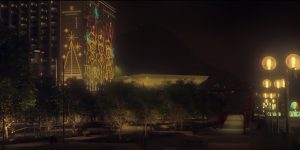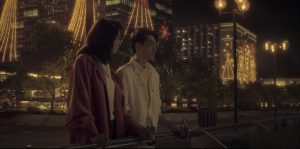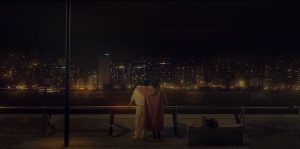ANITA; Longman Leung (2021)
TSIM SHA TSUI PROMENADE
Podcast: https://drive.google.com/file/d/1thF–0ppkfJ_fIecxhk5alD2tfAnlW7i/view?usp=sharing
Anita is a 2021 film directed by Longman Leung. It is a biographical film about the deceased Cantopop star, Anita Mui that visualizes her life from childhood to the last moment of her life till 2003 when she died of cervical cancer.
As the film shows events from the late 20 century to the beginning of the 21 century, many buildings were removed or renovated now, the production team faced challenges to construct sets to resemble the scene from the past. The director made use of graphical technology like greenscreen and CGI (沈洛嘉, 2021b), and also carefully curated the mise-en-scene to portray old Hong Kong. With the changes in the environment of the Tsim Sha Tsui Harbour Promenade and the surrounding building environment within these 30 to 40 years, what we experienced in the sites was quite different from the movie.
In one of the scenes, Anita Mui and Leslie Cheung, another Cantopop Star who was about to rise, were talking to each other in front of the Tsim Sha Tsui Harbour Promenade after Leslie Cheung was humiliated by the guests in the ballroom. Both of them were not yet famous singer at that time and their only opportunities were to sing in small ballrooms. However, Anita still believed that they would become successful someday and hold concerts in ‘Hung Gwan’ the Hong Kong Coliseum, the largest concert venue in Hong Kong, and they promised to invite each other to be the special guest of the show.

The director uses montage to relate the visual elements to the plot. When Anita said that they will be on the stage of the Hong Kong Coliseum, the shot is zoomed in and focuses on the Hong Kong Coliseum distance in the backdrop of the shot with the characters standing in the foreground of the Tsim Sha Tsui Harbour.

I can identify some buildings from the scene including Tsim Sha Tsui Centre, Intercontinental Grand Stanford Hong Kong(hotel), and Empire Centre. In the film, buildings behind the characters are decorated with Christmas lights. On the day we visited the site, there were no Christmas lights at all. And in recent years, the number of this kind of Christmas light in Tsim Tung has reduced a lot. Instead, the building made various types of Christmas lights such as installation art and LED light boards. Therefore the Christmas light with simple colors and patterns behind the characters can successfully depict the atmosphere of Hong Kong in the 1980s-1990s to let the audiences immerse in the nostalgia of the film.
To collect references for constructing the scene, the CGI team collected photos from the old times such as photos of their parents dating by the Tsim Sha Tsui Promenade. It was a popular spot for people to go on a date or to have a deep talk, the filmmakers believe that this scene will leave a heart-warming impression on viewers. I remember seeing those Christmas lights in Tsim Tung when I was young, and it was a collective memory for many Hong Kong people as well.

Since the shooting took place in front of a green screen with only the railings and benches as real objects, it took many procedures of assembling layers and color grading for the team to transform the raw footage into the final scene. As we visited the site we could identify the spots in front of the promenade railings where the camera might have been placed to create the basic storyboard varying in shot lengths, whereas some other shots may require the camera to be extended beyond the land to capture the characters facing the harbor.
Nowadays, the Tsim Sha Tsui Harbour Promenade is often occupied by tourists taking photos and sightseeing, contrasting with the quiet place shown in the scene. I believe that the director chose to film in this way to reduce distractions on-site and focus on the dialogue. Besides, reducing the number of pedestrians can also indicate that they are talking late at night after they get off work from the ballroom.


Moreover, when they are imagining taking a bow to the audience in the concert, they are facing the light coming from the skyscraper on the opposite side of Victoria Harbour reminiscent of the crowd cheering with their lightsticks and LED sign boards in the concert. While the scenery of the dazzling Victoria Harbour now is similar to that shown in the film, the buildings in the film look different from reality. The wide shot and the contrast make the scene look grand, transitioning smoothly to the next scene showing their upcoming success.
—Chiu Man Tsoi Janette 3036078261, Ng Yuk Wing 3035987312
Bibilography
沈洛嘉. (2021b, September 30). 梅艷芳|搭荔園尖東海旁重現舊香港 導演梁樂民:貴到差啲想唔拍. 香港01. https://www.hk01.com/%E9%9B%BB%E5%BD%B1/683131/%E6%A2%85%E8%89%B7%E8%8A%B3-%E6%90%AD%E8%8D%94%E5%9C%92%E5%B0%96%E6%9D%B1%E6%B5%B7%E6%97%81%E9%87%8D%E7%8F%BE%E8%88%8A%E9%A6%99%E6%B8%AF-%E5%B0%8E%E6%BC%94%E6%A2%81%E6%A8%82%E6%B0%91-%E8%B2%B4%E5%88%B0%E5%B7%AE%E5%95%B2%E6%83%B3%E5%94%94%E6%8B%8D
I appreciate your insightful analysis of cinematic techniques of Anita. Also, it is excellent to dig into the stories/film-making process behind the film. However, I would like to see more reflections based on lectures, tutorials, readings, as well as your personal field trip. Regarding the classic sense that Anita and Leslie chatted in front of the Tsim Sha Tsui Harbour Promenade, there are several questions worth further reflection: Why the Tsim Sha Tsui Harbour Promenade is shaped as the representative site to recall the collective memory in the 1980s-1990s? Following the life span of Anita, is the spatial/urban transition captured by this film? How does Abbas’ writing (Building on Disappearance: Hong Kong Architecture and Colonial Space) shed light on the deconstruction and reconstruction of the setting in this film? Furthermore, a more visualized and dialogue-liked podcast would greatly enhance the appeal of your work.